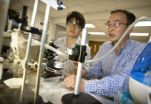(Press-News.org) VIDEO:
Henry Lim, M.D., chair of Dermatology, Henry Ford Hospital, highlights the study.
Click here for more information.
DETROIT – A treatment regimen is safe and effective for restoring skin pigmentation in vitiligo patients, according to a Henry Ford Hospital study.
"Our findings offer patients with vitiligo worldwide a renewed hope for a bright future in the treatment of this disfiguring disease," says Henry Lim, M.D., chair of Dermatology at Henry Ford and the study's lead author. "Patients with lesions on their face and arms could have a more rapid response to the combination treatment."
Henry Ford dermatologists described the repigmentation results as "superior," and said the treatment combination holds promise as a future therapy for the more than 50 million people worldwide living with vitiligo. It affects about one in every 100 people in the United States.
The study will be published online Wednesday in the Journal of the American Medical Association-Dermatology.
In a multi-center study led by Henry Ford, dermatologists sought to evaluate the safety and effectiveness of a treatment combination of afamelanotide, a drug that induces skin pigmentation, and phototherapy using narrowband ultraviolet-B rays (NB UVB). Phototherapy, or ultraviolet light therapy, is the treatment of choice for many patients with widespread vitiligo. It has been shown to be effective, though the degree of repigmentation varies.
Dr. Lim, an international vitiligo expert, says afamelanotide "enhances the ability of the UVB to induce repigmentation of the skin."
Patients were randomly divided into two study groups: Group A received the combination therapy; Group B received only NB UVB treatment.
Key findings:
Repigmentation occurred faster in patients who received the combination treatment compared to patients who received NB UVB.
Patients who received the combination treatment achieved appearance of pigment on their face and arms after 40 days compared to 60 days for patients who received NB UVB.
In dark-skinned patients, repigmentation occurred faster in the combination group compared to the NB UVB group.
Afamelanotide is in the process of being submitted for approval from the U.S. Food and Drug Administration for use in treating vitiligo.
Vitiligo is a skin disease that causes the skin to lose color and develop white patches that vary in size and location. It develops when cells called melanocytes are killed by the body's immune system, causing the area of skin to turn white because the cells no longer make pigment. Vitiligo is more noticeable in individuals with darker skin tones, but it affects all races and ethnicities.
While vitiligo is neither contagious nor life-threatening, there is no cure. However, it causes low self-esteem and depression for those living with the disease.
The Henry Ford study represents its latest research into investigating new treatment options for vitiligo. In a 2012 study published in the Journal of the American Academy of Dermatology, Henry Ford dermatologists showed the benefits of skin cell transplant surgery, called melanocyte-keratinocyte transplantation or MKTP. Henry Ford has since performed more than 190 MKTP procedures on patients from Michigan, 23 other U.S. states and Canada.
For this new study, 55 patients were enrolled at four sites – Henry Ford, Icahn School of Medicine at Mount Sinai in New York and Vitiligo and Pigmentation Institute of Southern California and University of California Davis' Department of Dermatology.
In the two study groups, 28 patients were enrolled in Group A and 27 patients in Group B. Both groups received phototherapy two to three times a week for six months for a total of 72 treatments. In addition to phototherapy, patients in Group A received a dose of 16 mg of afamelanotide in four monthly treatments. Afamelanotide, about the size of a grain of rice, was implanted just under the skin.
Two common vitiligo assessment scoring systems – Vitiligo Area Scoring Index and Vitiligo European Task Force – were used to evaluate the repigmentation response.
While patients in both groups showed repigmentation, the response in Group A was superior to Group B by the 56th day of treatment and even better by the 168th day of treatment. The most common side effect was redness of the skin.
INFORMATION:
The study was funded by Clinuvel Pharmaceuticals.
Vitiligo treatment holds promise for restoring skin pigmentation
2014-09-17
ELSE PRESS RELEASES FROM THIS DATE:
Combo of phototherapy, drug results in faster repigmentation in vitiligo
2014-09-17
Bottom Line: Patients with the skin depigmentation disease known as vitiligo had faster and better repigmentation after a combination therapy of the implantable drug afamelanotide and narrowband UV-B (NB-UV-B) phototherapy as part of a clinical trial.
Author: Henry W. Lim, M.D., of Henry Ford Hospital, Detroit, Mich., and colleagues.
Background: Vitiligo is characterized by white patches of skin and affects 1 percent to 2 percent of the population. The authors report the results of a multicenter randomized clinical trial comparing the safety and effectiveness of the ...
Chromosome buffers hold key to better melanoma understanding
2014-09-17
Buffers that guard against damage to the ends of chromosomes could hold the key to a better understanding of malignant melanoma – the deadliest form of skin cancer – according to new research from the University of Leeds.
The study has uncovered an important new genetic risk factor for melanoma.
It is well known that pigmentation and mole count are the strongest indicators of those most at risk of developing melanoma. For example, paler people should take more care in the sun, as they burn more easily.
It now appears that another risk factor is the length of telomeres, ...
NASA sees Tropical Storm Polo intensifying
2014-09-17
Tropical storm warnings now issued for a portion of the Southwestern coast of Mexico as Polo continues to strengthen. Infrared imagery from NASA's Aqua satellite showed powerful thunderstorms around the center of the storm.
A Tropical Storm Warning is in force for the southwest coast of Mexico from Punta San Telmo to Playa Perula. A Tropical Storm Watch is in force from Punta San Telmo to Zihuatanejo and from Playa Perula to Cabo Corrientes. Rainfall totals of 5 to 10, locally up to 15 inches, can be expected over coastal areas of Michoacan, Colima and Jalisco states ...
NASA sees Hurricane Edouard far from US, but creating rough surf
2014-09-17
Although NASA's Aqua satellite showed that Hurricane Edouard is far from U.S. soil, it is powerful enough that it is creating dangerous swells along the U.S. East Coast.
On Sept. 17, the National Hurricane Center noted "Swells from Edouard will affect portions of the east coast of the United States north of Florida beginning today. These swells will likely cause life-threatening rip current conditions along most of the United States east coast for the next couple of days."
When NASA's Aqua satellite passed over Hurricane Edouard on Sept. 16 the MODIS instrument captured ...
Shorebird's beak inspires UT Arlington research on water collection
2014-09-17
A UT Arlington engineering professor and his doctoral student have designed a device based on a shorebird's beak that can accumulate water collected from fog and dew.
The device could provide water in drought-stricken areas of the world or deserts around the globe.
Cheng Luo, professor in the Mechanical & Aerospace Engineering Department, and Xin Heng, PhD candidate in the same College of Engineering department, published "Bioinspired Plate-Based Fog Collectors" in the Aug. 25 edition of ACS' (American Chemical Society) Applied Materials & Interfaces journal. ACS also ...
Scripps Research Institute chemists modify antibiotic to vanquish resistant bacteria
2014-09-17
LA JOLLA, CA—September 17, 2014—Scientists at The Scripps Research Institute (TSRI) have devised a new antibiotic based on vancomycin that is powerfully effective against vancomycin-resistant strains of MRSA and other disease-causing bacteria.
The new vancomycin analog appears to have not one but two distinct mechanisms of anti-microbial action, against which bacteria probably cannot evolve resistance quickly.
"This is the prototype of analogues that once introduced will still be in clinical use a generation or maybe even two generations from now," said Dale L. Boger, ...
Habitual Facebook users more likely to be caught in phishing scams
2014-09-17
Washington, DC (September 17, 2014) – Receiving an email that claims you are the recipient of a large sum of money from an unknown deceased relative immediately raises a red flag. These email scams are often trashed or filtered through spam folders. But what about on social networks where there is no filter? Where people can learn about your personal life with a few clicks? A recent study published in the Journal of Computer-Mediated Communication by a researcher at the University at Buffalo – State University of New York found that people who habitually use Facebook were ...
Failed Medicare payments law remains relevant
2014-09-17
PROVIDENCE, R.I. [Brown University] — As Congress adjourns this month for the November elections, one of the killed bills senators will step over on their way out the chamber door will be the Sustainable Growth Rate (SGR) Repeal and Medicare Provider Payment Modernization Act of 2014. In a new commentary in the journal JAMA Surgery, Dr. Eli Adashi recounts what he and other advocates saw as the merits of the originally bipartisan bill. The perennial trouble with how Medicare pays doctors will return for the next Congress, Adashi said, and broader trends in health care practice ...
A massive black hole has been found at the center of an ultra-compact galaxy
2014-09-17
A team of researchers, including an astronomer from Michigan State University, has discovered a huge black hole at the center of an ultra-compact galaxy – the smallest galaxy known to contain one.
The galaxy, known as M60-UCD1, was discovered last year by a team led by Jay Strader, MSU assistant professor of physics and astronomy. Strader was a member of the team that found the black hole.
The findings are detailed in the recent edition of the journal Nature.
The finding suggests that other ultra-compact galaxies also may contain massive black holes. And that those ...
New non-invasive technique could revolutionize the imaging of metastatic cancer
2014-09-17
Bioluminescence, nanoparticles, gene manipulation – these sound like the ideas of a science fiction writer, but, in fact, they are components of an exciting new approach to imaging local and metastatic tumors. In preclinical animal models of metastatic prostate cancer, scientists at Virginia Commonwealth University Massey Cancer Center, VCU Institute of Molecular Medicine and Johns Hopkins Medical Institutions have provided proof-of-principle of a new molecular imaging approach that could revolutionize doctors' ability to see tumors that have metastasized to other sites ...







